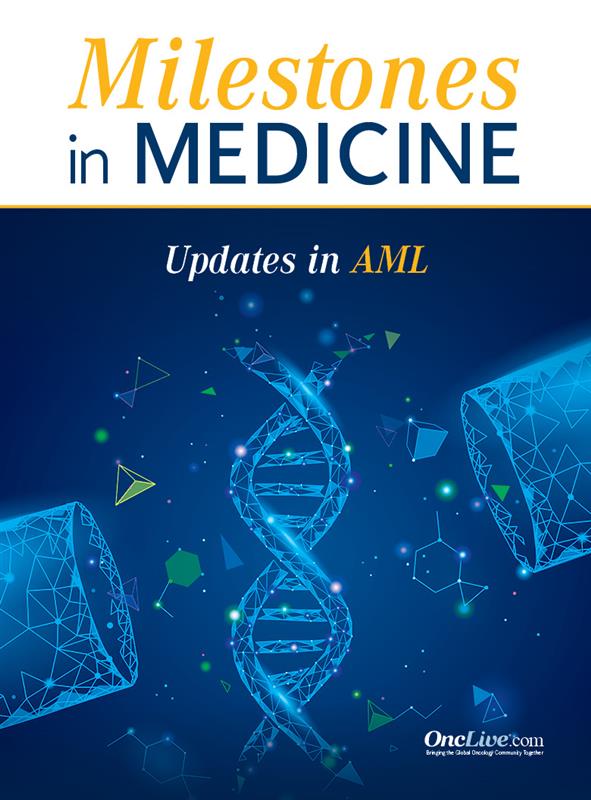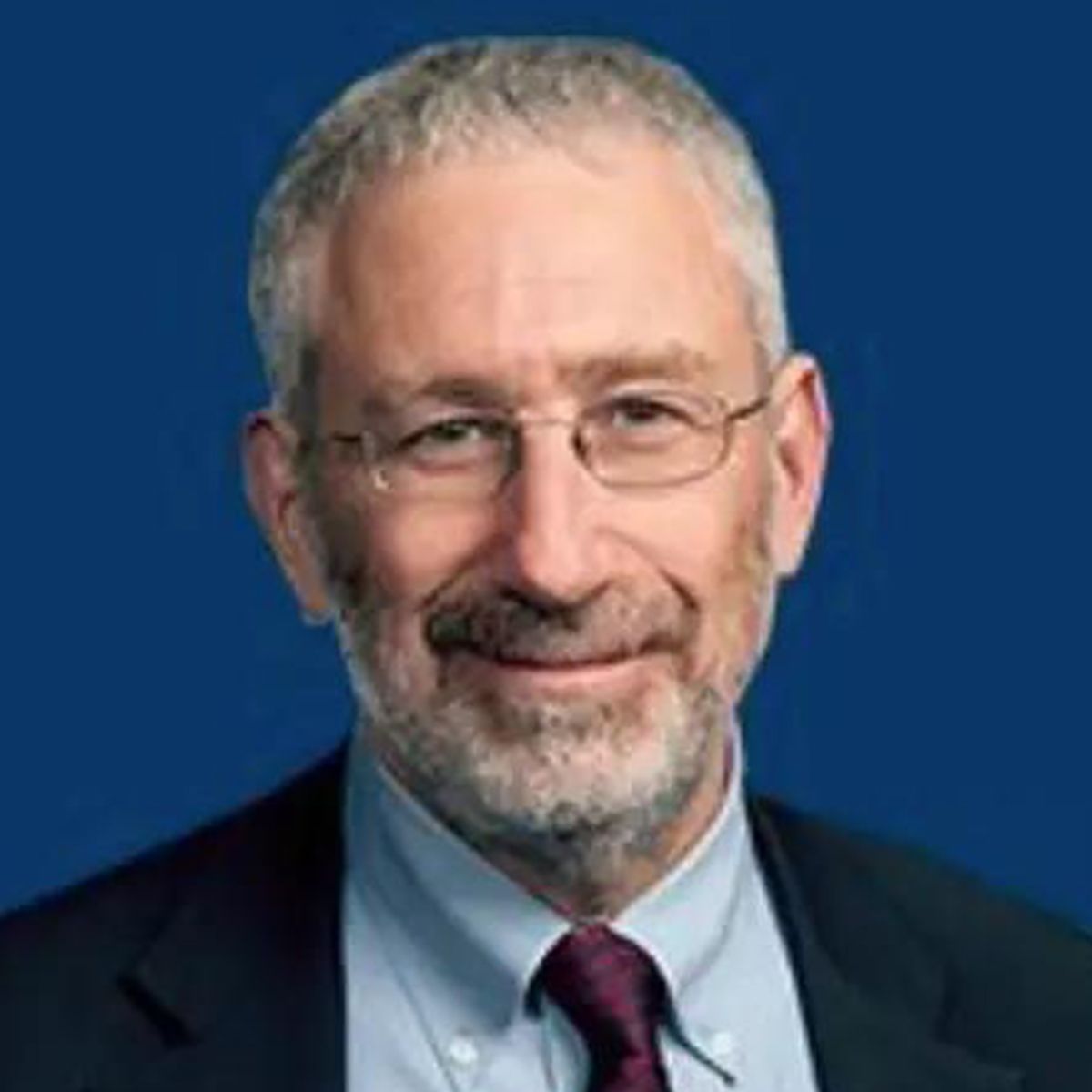Publication
Article
Uproleselan Plus Chemotherapy Could Provide MRD Benefit in Relapsed/Refractory AML
Author(s):
Although the exact role of minimal residual disease in patients with acute myeloid leukemia requires further definition, MRD status could help provide a clearer pathway for treatment decisions in this patient population.
Rory Shallis, MD

Although the exact role of minimal residual disease (MRD) in patients with acute myeloid leukemia (AML) requires further definition, MRD status could help provide a clearer pathway for treatment decisions in this patient population, according to Rory Shallis, MD.
The combination of uproleselan (GMI-1271) plus standard-of-care chemotherapy demonstrated beneficial remission rates in patients with relapsed/refractory AML, according to data from a phase 1/2 trial (NCT02306291). The combination produced a remission rate of 41% and a complete response (CR) rate of 35% in 54 patients. Additionally, among 16 patients evaluable for MRD through flow cytometry, 11 were found to be MRD negative.1
“[The role of MRD] is still being elucidated. We do think this is going to be a game changer for most, if not all, patients soon,” Shallis said.
In an interview with, OncLive®, Shallis discussed the benefit of MRD testing in AML, the investigation of uproleselan and E-selectin inhibitors in combination with chemotherapy and other agents, plus novel targets and therapies on the horizon in AML. Shallis is an assistant professor of medicine in the Department of Hematology at the Yale School of Medicine.
OncLive®: What is the benefit of MRD testing for patients with AML? How is this being used in AML?
Shallis: This is a timely question, for which there may be a better answer in 2, 5, and 10 years. The role is still largely unclear, though we have made some headway in some biological subsets of the disease. This is also predicated upon which [testing] platforms are being used. There are different methods of detecting and measuring MRD, whether it is through flow cytometry–, polymerase chain reaction–, or next-generation sequencing–based techniques.
There does appear to be some benefit [to MRD testing]. Most of this benefit at present is largely centered around the post-transplant benefit seen for some subsets of patients. Other molecular subsets where MRD testing may be of some value include patients that have disease harboring, if not driven by, NPM1 mutations. We are also learning about the core binding factor leukemias, and certain time points at which depths of remission or decreases in MRD quantification do predict improvements in event-based end points.
Regarding some of the more critical areas of need, TP53 mutations have been a focus over the years. This is largely due to the advent of therapies which are somewhat novel and may be able to induce greater depths of remission, particularly for those patients who are [candidates] for transplant. This is hopefully going to be most [patients in that subgroup] if they can accept the risks.
What are some ways that investigators are exploring the interaction of AML within the tumor microenvironment to assess and boost MRD negativity rates within these patients?
The role of the marrow microenvironment in the development of AML is becoming clearer. We still have much to learn, as prior attempts at addressing abnormalities that favor AML have yielded largely disappointing results. However, with every iteration of a negative study, there are lessons that are learned on the back end. This provides confidence in the pursuit, not only for effective leukemia-directed therapies, but for those [techniques] that make these therapies more effective.
Another timely subject is E-selectin, which is an adhesion molecule that is expressed in blood vessels during periods of inflammation. However, it appears to be expressed in a more protracted fashion among the vessel endothelium in the bone marrow of the microvasculature. E-selectin binds several molecules or ligands that are shown to be present on leukemic cells in the marrow, which leads to further upregulation of the E-selectin within the marrow endothelial [cells], up to 10 times the expected amount.
As a result, AML is hypothesized to be creating a protective niche that sequesters [leukemia] cells within the bone marrow and harbors them from some chemotherapies. This has been shown to predict more stubborn disease by way of allowing the activation or upregulation of other pathways that promote leukemic progression and chemotherapy resistance, which is a significant clinical problem since many of our patients with AML will be recommended to receive conventional and curative-intent chemotherapy.
What has been seen thus far with the use of venetoclax (Venclexta) in this patient population?
To opine briefly on the venetoclax data, this is relevant for patients that are going to be treated with less intensive therapy, such as azacitidine [(Onureg) with or without] venetoclax. Emerging data have shown in patient-derived xenograft models that the use of one of the E-selectin inhibitors can promote greater efficacy for hypomethylating agent [HMA] and venetoclax combinations, but to my understanding, there are no clinical data yet.
Could you expand on the design of the E-selectin inhibitor uproleselan and its potential role for the treatment of patients with AML?
Uproleselan is a small molecule and specific E-selectin inhibitor. Like many other early products, this was studied in preclinical experiments and was shown to disrupt the microenvironmental protection that leukemic cells enjoy. [Uproleselan] mobilizes these cells into circulation, improving some of the responses seen with classical chemotherapy agents such as cytarabine and anthracycline.
[The activity of uproleselan] does not appear to be dependent on a particular set of genetic or molecular profiles. It appears to be disease biology agnostic. There’s clinical experience with this agent, now published in combination with multiagent chemotherapy in phase 1 and phase 2 testing with MEC chemotherapy for patients with relapsed/refractory disease, and classical 7+3 chemotherapy for newly diagnosed disease.
Composite remission rates in the salvage cohort were 41%, including a CR rate of 35%, with [11 of 16 evaluable patients] achieving a MRD-negative remission by flow-based testing. These were single-arm trials that were indirectly compared with historical expectations [for other treatments for patients with AML], though there were no clear differences in time to or quality of count recovery, and relatively low rates of toxicity and mortality.
There was a lower-than-expected rate of mucositis. This has been attributed to the role E-selectin expression has on inflammation that may extend to extramedullary sites or sites outside the bone marrow, including the gastrointestinal tract. This may be relevant for older patients or may have other comorbidities, which may make the risk or implications of mucositis more troublesome.
For newly diagnosed AML [n = 25], the rate of composite remission rate was 72%, and [5 of 9 evaluable responders] achieved an MRD-negative remission. There does appear to be a correlation between E-selectin ligand expression on leukemic blasts prior to treatment and the response achieved. However, this is a correlative science that requires further study.
Uproleselan is being studied in a frontline randomized [phase 3] trial [NCT03701308] with 7+3 chemotherapy, and a placebo-controlled, randomized [phase 3] trial [NCT03616470] in combination with an accepted salvage chemotherapy for patients with relapsed/refectory disease, receiving up 2 lines of therapy.
Outside of the intensively treated patients, there are emerging data that patients who are not appropriate to receive intensive therapy may soon be beneficiaries of uproleselan treatment, as preclinical data suggest that this also yields similar effects when combined with an HMA. There are patient-derived xenograft models also suggesting efficacy with the accepted standard of an HMA and venetoclax.
There are 2 ongoing prospective [phase 3] studies that will hopefully yield a lot more science to inform the next generation of trials, incorporating this agent and others to come.
If uproleselan is found to have efficacy in combination with other agents outside chemotherapy, what would this mean for patients with AML?
It would be significant. Although there are some nuances depending on which dataset you look at, but about half of patients will be appropriate to receive intensive therapy, which is dictated by the patient profile and disease biology. There are some subsets of disease that the biology is predictive of stubborn disease. In this case, the risk/benefit calculation of intensive therapy is unfavorable for a patient who has limited chance of benefit. Conversely, there are patients who are older, but have favorable disease biology, where you may want to push the envelope a bit to put them in the best position for treatment, which might include intensive therapy.
The less intensively treated patients receive an HMA and venetoclax, which is an accepted standard for most patients. This is also disease biology agnostic outside of those poor-risk subsets, where you could get by with less [intensive treatment] and still achieve some of the same benefits.
[Adding uproleselan to these] treatments would cast a wide net. This is mostly going to be related to the preclinical science. Any agent that's going to be going into combination study must have some evidence [of a synergistic effect] before it reaches humans, which might predict better efficacy when used in combination.
Are there any other novel targets or novel therapies on the horizon that you're particularly excited about within AML?
I would argue this is the golden age of leukemia drug development, although [when we look back in 50 years], this could be considered the stone age. However, there are a multitude of agents that are being elucidated and moved forward in clinical trials. The best thing to do is basket them into certain larger categories.
In the microenvironment, there are other targets that may be more relevant to the spliceosome complex or more specific oncoprotein drivers of disease. The list of drugs for which there is at least some promise is extensive. It's probably in the dozens, but some are moving forward at a quicker pace and garnering more promise. This includes menin inhibitors, such as SNDX-5613 or ziftomenib [KO-539]. These are agents which are founded on reasonable, preclinical rationale and are moving forward in several trials.
There's also a product known as emavusertib [CA-4948], which is an IRAK4 ligand inhibitor for spliceosome-mutated diseases, applying to both AML and myelodysplastic syndromes. There are other compounds targeting RARA-rearranged disease, which is not a small subset of patients. Further, you can extend it to more cellular therapies. There are several therapies using decades of progressive experience and the understanding of NK cells and other CARs. There are many emerging, if not promising, agents, and there are some out there that we are excited about making their way to us in the clinic.
What are some of the biggest unmet needs in patients with AML that remain to be addressed?
This is a critical question, as there are certain populations of patients that are stuck behind the eight ball and in quite a difficult situation. Outside of being diagnosed with AML in general, there are populations of patients that we wish we had a bit more in our toolkit to help them out.
[Unmet needs remain] in any patient who has disease which has proven to be refractory or relapsed after an initial achievement of remission. There are other options, including some approved agents, but it's hard to parse out which one is the standard in many of these cases outside of FLT3-mutated disease, for which there is randomized data to suggest there is at least 1 good treatment option [with gilteritinib (Xospata)].
In any patient that needs salvage therapy, you are probably looking at about a 30% to 40% chance of having any meaningful response to therapy, which, for most patients, is not long lasting. We need better salvage therapies in general. In salvage therapy, this is where more targeted therapies would make more sense to get patients to an allogeneic hematopoietic stem cell transplant.
Venetoclax-based regimens are a commonly used salvage approach, but once a patient has failed a venetoclax-based combination, we enter a gray zone. We need better therapies [for this situation], and there are efforts that are ongoing that are looking at that specific disease subset.
Outside of that, salvage and frontline treatment of TP53-mutated disease [remains an area of need]. There is a limited prospect for long-term remission and cure in [these patients]. There are several products that are being studied with limited success. If there are some successes, it is probably too early to have substantial enthusiasm. However, it is nice to have a first iteration to guide the next generation of trials based on the data gained.
Reference
- DeAngelo DJ, Jonas BA, Liesveld JL, et al. Phase 1/2 study of uproleselan added to chemotherapy in patients with relapsed or refractory acute myeloid leukemia. Blood. 2022;139(8):1135-1146. doi:10.1182/blood.2021010721










